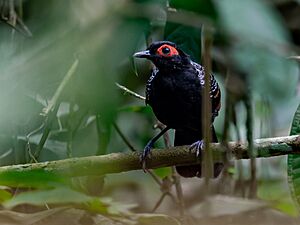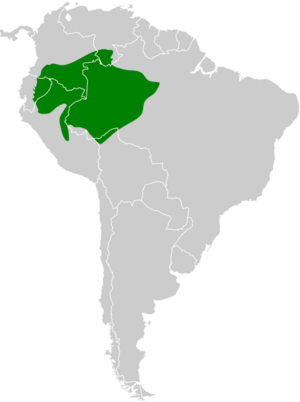Reddish-winged bare-eye facts for kids
Quick facts for kids Reddish-winged bare-eye |
|
|---|---|
 |
|
| male | |
| Conservation status | |
| Scientific classification | |
| Genus: |
Phlegopsis
|
| Species: |
erythroptera
|
 |
|
The reddish-winged bare-eye (Phlegopsis erythroptera) is a cool bird that eats insects. It's part of a group called "typical antbirds" because they often follow ants to find food! You can find this bird in countries like Bolivia, Brazil, Colombia, Ecuador, Peru, and Venezuela.
About the Reddish-winged Bare-Eye
How Scientists Name Them
The reddish-winged bare-eye was first described by an English bird expert named John Gould in 1855. He gave it the scientific name Formicarius erythroptera.
This bird has two main types, called subspecies:
- P. e. erythroptera (the original type)
- P. e. ustulata
What Does the Reddish-winged Bare-Eye Look Like?
This bird is about 17 to 18.5 centimeters (6.7 to 7.3 inches) long. It weighs between 50 and 58 grams (1.8 to 2.0 ounces).
Both male and female reddish-winged bare-eyes have a large ring of bright red skin around their eyes. This is where they get the "bare-eye" part of their name!
Male Birds
Adult male birds are mostly black. They have white edges on some of their feathers, especially on their upper body and wings. Their wing feathers also have wide reddish-brown tips and bases.
Female Birds
Adult female birds look a bit different. Their head, upper body, and wing feathers are a very dark reddish-brown. Their flight feathers are blackish-brown with white tips. They have a pale band across their tail. The center of their throat is a light, yellowish-brown color. Their face and belly are reddish-brown, and their sides are reddish-brown too.
Younger Birds
Younger males look similar to adult males but are grayer. They have reddish-brown edges on their back feathers and reddish-brown colors on their wings.
Differences in Subspecies
Males of the P. e. ustulata subspecies have completely black feathers on their upper tail. Females of this subspecies have light, yellowish-brown tips on their wing feathers.
Where Do Reddish-winged Bare-Eyes Live?
The reddish-winged bare-eye lives in different parts of South America.
- The P. e. erythroptera subspecies is found in southeastern Colombia, southwestern Venezuela, eastern Ecuador, northeastern Peru, and northwestern Brazil.
- The P. e. ustulata subspecies lives in eastern Peru, northwestern Bolivia, and southwestern Amazonian Brazil.
These birds mostly live in the lower parts of wet, evergreen forests. Sometimes, they can also be found in smaller woodlands that grow on white sand. They usually live below 550 meters (1,800 feet) in elevation. However, in Ecuador, they can be found up to 750 meters (2,460 feet) high, and in Colombia, up to 600 meters (2,000 feet).
Reddish-winged Bare-Eye Behavior
Movement and Home
Scientists believe that the reddish-winged bare-eye stays in the same area all year long. It does not migrate to different places.
What Do Reddish-winged Bare-Eyes Eat?
The reddish-winged bare-eye is a special kind of bird called an "obligate ant follower." This means it always follows swarms of army ants to find food! As the ants march, they scare out all sorts of small creatures like insects and spiders. The bare-eye then swoops in to catch them.
These birds usually hunt alone, in pairs, or in family groups. They perch close to the ground, usually within 1 meter (3 feet), but sometimes as high as 3 meters (10 feet). From there, they quickly fly or pounce onto the ground to grab their prey. They might also fly short distances to catch insects in the air or flip over leaves on the ground to find hidden food.
Sometimes, several pairs or family groups might follow the same ant swarm. The reddish-winged bare-eye is usually stronger than most other birds that follow ants, so it often gets the best spots for hunting.
Reproduction and Life Cycle
We don't know much about when the reddish-winged bare-eye builds its nests or lays eggs. It seems to happen between October and June in Ecuador, and in January in Colombia. Beyond that, there isn't much information about how these birds raise their young.
How Do They Communicate?
The song of the reddish-winged bare-eye is a series of 4 to 7 high-pitched notes that go down in sound. It sounds like "rrr RHEEEW-rheeew rheeew rhew rhhw".
They also make calls, like a quick "chip" sound and a short, sharply downward-sloping "chirr."
Status and Conservation
The IUCN (International Union for Conservation of Nature) says the reddish-winged bare-eye is a species of "Least Concern." This means it's not currently in danger of disappearing.
It lives across a very large area. We don't know exactly how many of these birds there are, but their numbers seem to be going down. No big threats have been found right now.
Even though it's not endangered, the reddish-winged bare-eye is generally not very common. It's considered "scarce" in Ecuador and "rare to uncommon" in Peru. It lives in some large protected areas and also in big areas of untouched forest that are not officially protected but seem safe for now. However, these birds are thought to be very sensitive to human activity and changes in their habitat.


